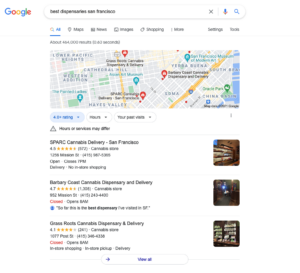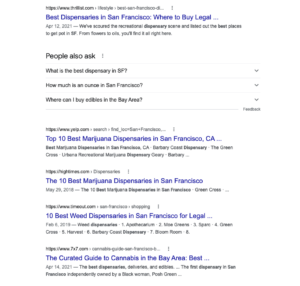A Crash Course to Dispensary SEO
In this Internet Age, any business must have a substantial online presence in order to stay relevant in their respective industry. In the cannabis industry, this is even truer. With cannabis marketing restricted by advertising regulations, a dynamic digital marketing strategy is a must for any cannabis business.
In this article, we discuss how to integrate SEO (Search Engine Optimization) into your dispensary marketing strategy.
What is Search Engine Optimization?
SEO is the name given to the process of improving the quality of internet content in order to better its standing in search engine indexing. Easy enough, right? No?
So what does that even mean?
Imagine you want to visit a dispensary in San Francisco. You go to Google and type “best dispensaries San Francisco.” When you press search, something called a SERP ” or Search Engine Results Page ” shows up. That’s just a technical name for the search results page.
The SERP is ordered in a particular way. Google has a sophisticated algorithm orders its search rankings. On the top, you are likely to see what has become known as a “Google Map Pack,” which shows a map with three businesses most relevant to your search listed below it.

Underneath the Google Map Pack, you are likely to see a more traditional list of sites, like this:

Also take notice of the “People also ask” section of the SERP. While not seen here, you may also see some results that say “Ad” before them. These rank highly because they are, well, ads. Companies pay for these results to show up.
Buying an ad is not an SEO strategy. SEO helps generate “organic traffic.” Organic traffic refers to web visitors who come upon your site without it being sponsored or otherwise incentivized.
While purchasing an ad is certainly worthwhile in certain circumstances, this article is interested in exploring SEO and how you can frame your content so people come upon it naturally.
SEO allows you to position yourself higher in the search rankings. The higher you are (pun not intended), the more web traffic you will generate.
Does SEO really matter?
The short answer: yes.
In the digital age, when so many people use search engines before making any purchase decisions, generating traffic to your website is more important than ever. Without a substantial web presence, cannabis companies are doomed to fall behind to their competition.
While web traffic can be gained in many ways, including social media and paid advertising, no avenue is more effective than SEO. There are two main explanations for this.
First, SEO requires effort and, perhaps, an initial investment, but, unlike advertisements, it does not require continuous payments. It is a cheaper alternative to advertising your website or paying to promote it in search results.
Second, SEO is simply more effective. According to Moz, a company specializing in SEO Software Tools, out of the tens of billions of Google searches performed each month, only 3.4% resulted in a click on a paid ad.
Not only is search engine optimization cheaper than ads, but it also taps into the organic search results that Google users evidently prefer.
Presumably, you have invested in your website ” and importantly so. In the cannabis industry, having a strong website is a must. But without integrating SEO into your digital marketing strategy and prioritizing generating traffic to your website, it can all be for nothing.
Dispensary marketing is more competitive than ever, and, unfortunately, dispensaries too often overlook the importance of search engine optimization.
How to develop an SEO Strategy
Developing an SEO strategy can be intimidating because of just how wide the internet feels. It can seem difficult to identify a place to begin. In the following sections, this article will help you get started with building an effective SEO strategy that works for your dispensary’s business needs.
What is your dispensary’s identity?
The first step in developing any effective SEO strategy requires some soul searching. Consider your dispensary and your audience. Who are your customers? Who is your target audience? Do you specialize in something? Is your overall cannabis marketing strategy geared toward a certain demographic?
Defining your target audience is crucial to developing any successful digital marketing strategy ” but especially so with SEO. This is because the first step with SEO is predicting what your target audience and customers are searching on search engines.
Anticipating Search Terms
Put yourself in your target customer’s shoes. What are they typing into Google that you hope leads them to your site and, ultimately, your store?
For example, a common search term is “dispensaries near me.” With a strong SEO strategy, you can make sure your dispensary shows up as high as possible when someone Google searches for dispensaries.
Other possible searches may include “best dispensary in *your city*” or “recreational dispensary.”
Your job is to predict what your target customers are wondering and looking for. You cannot be too broad (targeting “recreational marijuana” may be too ambitious), but you also cannot be so specific that you are unlikely to increase traffic from it. For instance, targeting “best recreational marijuana dispensary in Reno Nevada that sells Strawberry Cough concentrate” is too specific as few people are likely to make such a search.
The search terms you target will vary based on your business, but it is important to think hard about this before committing effort to pursuing one particular search term.
Mediums for SEO
Okay. SEO is important for business. Got it. But where do you even apply it? What content needs to have search engine optimization?
While users often associate SEO with blogs and long-form webpages, SEO is, in fact, important for all facets of your website. Every page on your website can benefit from an SEO tune-up, from your dispensary website’s front page to its “about” section.
While SEO is relevant to every page, some cannabis companies write long-form blog posts and articles in order to drive traffic to their website. Once an internet user has arrived at their article, scattered hyperlinks throughout the article drive traffic to other places on the site.
This works because articles and blog posts are uniquely situated for success in search engine indexes. Consider adopting this strategy.
Outside Resources
SEO is complex, and depending on your cannabis business’s needs, you may want to consider getting external support for developing and implementing your SEO strategy. There are two primary methods of getting outside help.
Software Assistants
The first is using an SEO software tool to assist in your writing. There are many such services, and each vary slightly. These will help you implement effective SEO once your strategy and goals are well defined. Typically, these tools make recommendations on your writing to maximize SEO.
SEO Agency
The second is to hire an SEO agency. This approach is certainly the most expensive approach, but, in some circumstances, it is a worthwhile investment. These firms specialize in SEO and are likely to offer the most comprehensive support.
Whether or not you should opt for one of these avenues depends on your cannabis business and its specific needs. It is certainly not a necessity in most instances. Keep reading for techniques that can help you achieve your SEO goals without external services.
Techniques to Maximize Dispensary SEO
The actual nitty-gritty of boosting SEO is complicated for a number of reasons. First, the algorithms that search engines use to order their search results are often updated. You may rank second for a certain search criteria one month, and one day realize you have been moved to third even though none of the content changed.
Because of this, SEO requires frequent attention. Meeting your goals is only half the battle: you need to also ensure you maintain your goals.
We now get into the pieces of the SEO puzzle. What goes into calculating SEO?
Keywords
The most basic element of search engine optimization is “keywords.” Keywords are the building block of any SEO effort.
Keywords are the terms used by internet users on a search engine, and keywords are targeted by those engaged in SEO. The first step in developing an SEO strategy is to decide on which keywords you wish to target.
If you are a dispensary in Seattle, you may want to invest in SEO for the keywords “marijuana dispensary Seattle.” These keywords are likely highly competitive, given the amount of dispensaries competing in Seattle and the number of people likely to make such a search. The same dispensary may also invest in SEO for the keywords “sativa edibles Seattle.” Since these keywords are more specific, they are likely to have less competition but also less overall traffic.
With your keywords determined, you may begin to build your content.
Headings
When calculating the relevance of your content for the keywords used in a particular search, the search engine gives extra weight to “headings.” What are headings?
Headings, or (sometimes) headers, are used to break up your content by section. This section of this article, for instance, has the heading “Headings.” In addition to being larger and in bold, the heading is specially marked in the site’s code, essentially telling the search engine that it is a heading.
There are, typically, six different types of headings: H1, H2, and up to H6. H1 is the largest and most overarching, while H6 is the smallest and most specific, usually falling within a larger heading’s section.
Many assume SEO prioritizes H1 over H2 over H3, etc. But this is not exactly true. As John Mueller of Google explains in the Search Engine Journal, the type of heading is no longer relevant to SEO. Mueller explains that, today, Google uses headings as a way to understand what the paragraphs that follow the heading are about.
This is not to say that headings are unimportant. They are certainly one of the key components of SEO. In order to capitalize on your headings, use them frequently and incorporate descriptive keywords into them.
Using terms like “cannabis,” “dispensary,” and your city in your headings is a great idea. This increases your chance of coming up high in the search engine result when someone searches for similar things.
Images

SEO loves images. Integrating images in your content almost always improves your SEO. Be sure to use relevant and high-quality images that you are licensed to use (or that are free-to-use). Do not forget to attribute credit where necessary.
Incorporating images is a strong SEO and digital marketing techniques simply because it makes your content more attractive and engaging, as well as leads to your content existing on Google Images and other search engine image results.
Using a Meta Description
You can also attach something called a “meta description” to your images. Meta descriptions are invisible to viewers of your website but are integrated into the code of the image. Many website building software tools allow you to easily include a meta description on your image.
Your meta description should be relevant to the image it is attached to. Some people see meta descriptions as opportunities to cram in keywords and boost their SEO. Do not do this. Search engines can usually detect this practice, and it will penalize your ranking.
Hyperlinks

Using hyperlinks is another effective SEO strategy.
Hyperlinks are essentially links built into your content that lead to other relevant pages. They are also a good way to credit sources. For instance, this text is hyperlinked to a springbig blog about the dos and don’ts of cannabis marketing.
Featuring a healthy number of hyperlinks in your content is a proven way to boost your credibility and your SEO standing.
Hyperlinks can generally be sorted into two categories:
1) Internal Links
Internal links are hyperlinks which lead to another place on the same website. For instance, the hyperlink above, which leads from this springbig blog to a different springbig blog also on the springbig website.
2) External Links
As you may have guessed, external links, unlike internal links, are hyperlinks which lead to somewhere on another website. An example is this hyperlink, which leads to the Google Images results for “cannabis.”
When integrating external links into your content, be sure to avoid broken links. Broken links refer to hyperlinks which, likely due to changes on the other website, no longer lead where you intended them to. They are more common than you might think, so regularly confirm that your links are stable.
Which Type of Hyperlink is Best?
Including a healthy balance of each is a strong strategy for dispensary SEO. However, be sure to be selective with your external hyperlinks. Make sure they link to credible and generally well-respected sources.
Don’t try to trick search engines!
When trying to improve your dispensary SEO, it may be tempting to try and boost your search engine optimization artificially, such as by cramming keywords or using invisible headings.
The algorithms used in Google search and other search engines are trained to detect these. Not only do strategies like these usually fail, they often decrease your SEO ranking.
The best practice for search engine optimization is to stay authentic.
Navigating Local SEO

With some techniques for general SEO covered, this article turns to an important piece of dispensary marketing: local SEO. For dispensary marketing ” even more so than general cannabis marketing ” it must be made a priority.
What is Local SEO?
Local SEO is the practice of boosting your website’s organic traffic specifically in the area surrounding your business or dispensary. It is especially important for brick-and-mortar retailers who sell products to in-person customers.
A strong local strategy allows your cannabis business to appear high in the rankings when a customer makes a cannabis related Google search in your area. By boosting your name and brand, you will drive customers into your dispensary rather than your competition’s cannabis business.
Examples
Suppose someone is visiting Seattle and is interested in purchasing cannabis. They open Google and search “dispensary in seattle.” The top results are likely to look something like this:
Google automatically generates local results like the one seen above. This is often referred to as a Google Map Pack.
Businesses listed in Google Map Packs are shown to dominate local web traffic. One report claims that listings in Google Map Packs gain roughly 44% of all clicks on local searches.
According to the Google My Business Help page on improving your local ranking, “Local results are based primarily on relevance, distance, and prominence. A combination of these factors helps us find the best match for your search.”
Keeping Your Dispensary Locally Competitive
As of today, local SEO runs through Google, and giving your dispensary a strong presence on Google begins with Google My Business (GMB).
What is Google My Business?
Google My Business is Google’s platform for business owners to share information about their business to be integrated into Google Maps and other localized Google searches. It is built especially for businesses with physical locations.
How to Get Started with Google My Business
Google makes it simple to get started. Go to the sign up page, log in with your credentials, and fill out as much information about your company as possible.
Be creative and accurate when describing your dispensary. If your business already appears, ensure all the information is up to date and consider how you might improve it to make it more interesting.
Use keywords to describe your dispensary’s specialties. What are you known for? Who are you trying to attract?
Tracking your Results

As with all sides of cannabis marketing, dispensary SEO is only worthwhile if it is leading to results. Tracking results is necessary to determine what is working and what needs improvement.
There are a number of ways to track results but none are as popular as Google Analytics.
Google Analytics is key to tracking your results and progress, but it can also be overwhelming to navigate. While using all that Google Analytics has to offer may require patience or signing up for Google’s Analytics Academy ” or just hiring someone with proficiency – it can be used for more basic insights as well.
For cannabis companies using Google Analytics specifically for dispensary SEO, the valuable data exists in organic search traffic. Google Analytics will separate your organic traffic from your traffic that comes through other channels, like paid advertisements. If you are seeing your organic search traffic improve, then your new SEO strategy is coming along great!
If you are noticing that not much is changing, keep trying! SEO in dispensary marketing is a marathon, not a sprint. Stay patient, keep trying different things, and the results will follow.
Dispensary Marketing Beyond SEO
In the competitive and fast-paced cannabis industry, dispensaries need a lucrative digital marketing strategy in order to differentiate themselves among the competition. A sophisticated SEO strategy is an important and necessary piece of the puzzle, but it is only one part. Reaching and maintaining success in the cannabis industry is a constant effort.
Fortunately, springbig’s marketing suite can manage most of your dispensary’s marketing needs. With our loyalty program’s point-per-dollar rewards, incentivize returning customers while attracting new ones. With our fully customizable SMS text message marketing platform, instantly reach and manage countless customers, both potential leads and familiar faces. Easily segment customers based on their spending habits or whatever criteria you desire.
Springbig ensures your marketing efforts remain compliant with all relevant regulations ” managing the burden of all the regulations of the cannabis industry so you don’t have to. Easily integrated into all industry leading P.O.S. software, getting springbig into your dispensary couldn’t be easier and is right for just about any dispensary.
To learn more, request a demo here.


